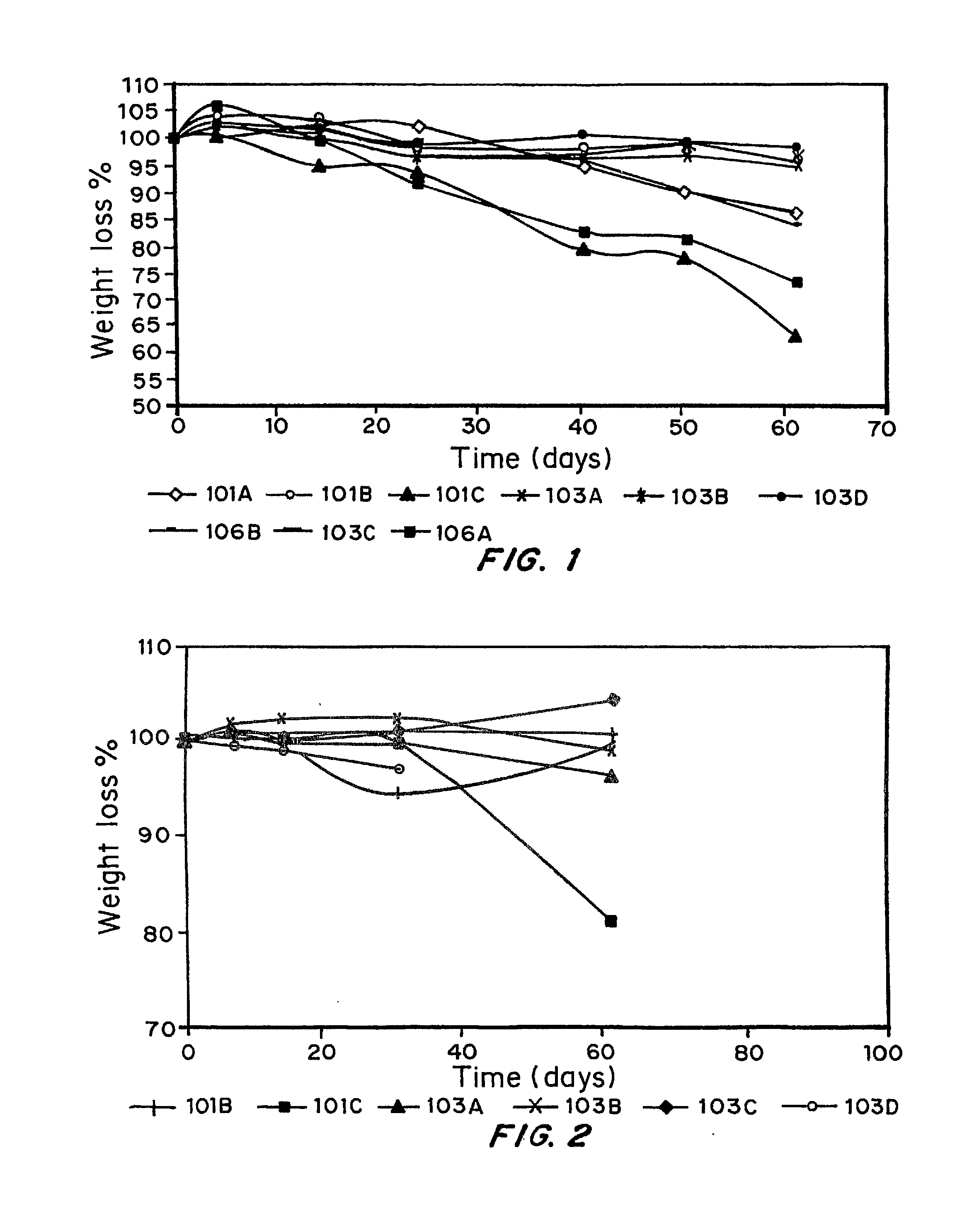Disposable Medical Supplies From Hydrolytically Biodegradable Plastics
- Summary
- Abstract
- Description
- Claims
- Application Information
AI Technical Summary
Benefits of technology
Problems solved by technology
Method used
Image
Examples
example 1
Manufacture of a Syringe Composed of Poly(butylene glycerol adipate)
[0071]Poly(butylenes-glycerol adipate) was synthesized by polycondensation of butylene glycol, adipic acid, and glycerol (all available from Aldrich) at a 1.5:2:0.5 mole ratio for 5 hours at 150° C. under a vacuum of 50 mTorr. The polymerization yielded a transparent, almost colorless uncrosslinked elastomer that did not swell or dissolve in water. When a butylene glycol:adipic acid:glycerol ratio of 1:1:2 was used, a rigid, crosslinked polymer was obtained. The uncrosslinked polymer was injection molded at 200° C. to form the barrel of a 10 ml syringe.
example 2
Synthesis of Adipic Acid Based Polyesters
[0072]To a 500 ml flask, 60 g of adipic acid and 192 g of succinic acid were added while slowly increasing the temperature to 200° C. and water was effused out. When the temperature reached 200° C., 130 g of 1,4-butanediol and 0.5 g of phosphoric acid, a catalyst, were added to the reaction mixture and the mixture was reacted at 200° C. for 5 hours at 1 mmHg. The biodegradable resin had a number average molecular weight of 22,000, a weight average molecular weight of 60,000 and a melting point of 95° C. as measured by DSC. Other branched polyesters can be prepared in a similar fashion.
example 3
Synthesis of Prepolymers Based on Adipic Acid and Diols with Ricinoleic Acid or Castor Oil
[0073]The time, ratio of reagents and use of sulfuric / phosphoric acids as catalysts were investigated in order to prepare prepolymers with the highest Mn / Mw possible. The polymerizations were carried out at temperatures between 180 and 200° C. Table 1 lists the different Number average (Mn) and Weight average (Mw) molecular weights obtained for a variety of adipic acid-based polyesters formed using different reagents and catalysts.
TABLE 1Number Average and Weight Average Molecular Weights(Da) for Adipic Acid-Based PolyestersMnMwAdditional monomersMonomer IIMonomer ILinear / Branched prepolymers: without any catalyst:2.5 h at a pressure of 1 mm Hg and atemperature of 180-200° C.67124403EthyleneAdipic acidglycol6712440320% Ricinoleic acidEthyleneAdipic Acidglycol6221297320% castor oilEthyleneAdipic acidglycol61023655PropyleneAdipic acidglycol1353103420% Ricinoleic acidPropyleneAdipic acidglycol2735...
PUM
| Property | Measurement | Unit |
|---|---|---|
| Thickness | aaaaa | aaaaa |
| Thickness | aaaaa | aaaaa |
| Mass | aaaaa | aaaaa |
Abstract
Description
Claims
Application Information
 Login to View More
Login to View More - R&D
- Intellectual Property
- Life Sciences
- Materials
- Tech Scout
- Unparalleled Data Quality
- Higher Quality Content
- 60% Fewer Hallucinations
Browse by: Latest US Patents, China's latest patents, Technical Efficacy Thesaurus, Application Domain, Technology Topic, Popular Technical Reports.
© 2025 PatSnap. All rights reserved.Legal|Privacy policy|Modern Slavery Act Transparency Statement|Sitemap|About US| Contact US: help@patsnap.com

